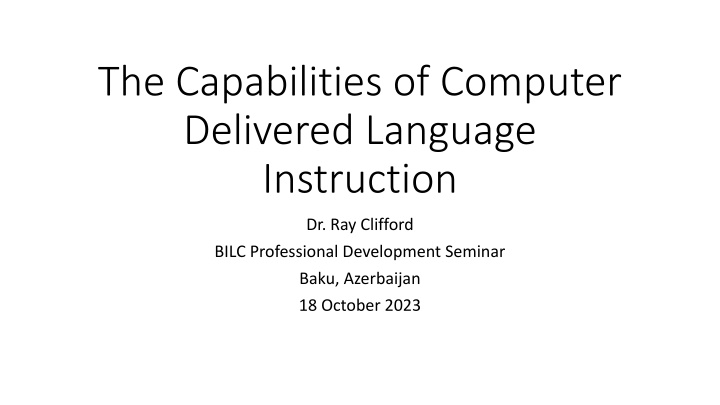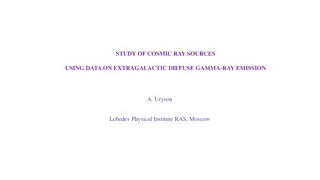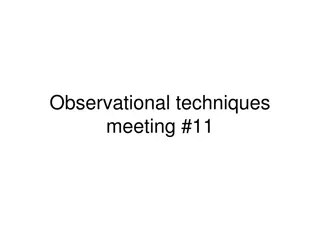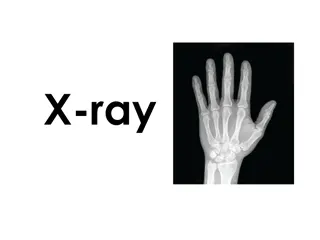
Computer-Delivered Language Instruction: Challenges and Responses
Explore the implications of shifting to computer-based language instruction in response to cost-saving measures in education. Delve into the complexities of language learning outcomes, teaching techniques, and the importance of quality instruction over cost-cutting measures.
Download Presentation

Please find below an Image/Link to download the presentation.
The content on the website is provided AS IS for your information and personal use only. It may not be sold, licensed, or shared on other websites without obtaining consent from the author. If you encounter any issues during the download, it is possible that the publisher has removed the file from their server.
You are allowed to download the files provided on this website for personal or commercial use, subject to the condition that they are used lawfully. All files are the property of their respective owners.
The content on the website is provided AS IS for your information and personal use only. It may not be sold, licensed, or shared on other websites without obtaining consent from the author.
E N D
Presentation Transcript
The Capabilities of Computer Delivered Language Instruction Dr. Ray Clifford BILC Professional Development Seminar Baku, Azerbaijan 18 October 2023
This is a timely topic in the United States Recently, the President of a major U.S. university announced that his university was going to stop teaching foreign languages. When his decision was challenged, he responded that he would either Have future classes taught by another university. Or He would have the students learn using a computer app. Shortly thereafter, his vice president asked my university if we would be willing to teach their foreign language classes.
How would you have responded? The president s obvious goal was to save money. How did he plan to save money? Could languages be taught cheaper by computers or through distance learning classes? Would he expect you to pay your teachers less than his teachers were being paid? Would you consider it a complement if your language programs were compared to the abilities of a computer app?
Our response: Part 1 A discussion of alternative instructional options should begin by considering the program s desired learning outcomes. The outcomes normally associated with second language instruction center on the goals of a) developing the language skills needed to accurately discuss facts, beliefs, and abstract ideas with speakers of another language. b) helping students acquire cultural insights that are not available from a monolingual perspective, c) preparing students for global careers in any of the university s other majors, and d) raising students awareness of the complexities of language and the vagaries of their first language.
Our response: Part 2 As a minimum, attaining these instructional outcomes requires teaching activities that combine extemporaneous communication exchanges with formative feedback that is timely, accurate, sufficiently informative to improve the students performance, tailored to each learner s individual needs, and structured to provide incremental improvement.
Our response: Part 3 Neither of the proposed alternatives to face-to-face instruction can meet the dual objectives of saving money and providing quality language instruction. 1. Computer-delivered language instructional programs are cheaper, but they don t produce the expected outcomes. a) Language teaching apps focus on the rote memorization of language phrases and provide instruction in a limited set of communication domains. b) Computer programs (including those that use artificial intelligence) are unable to provide learners with the tailored feedback that they need for effective learning.
Our kinder response: Part 4 Neither of the proposed alternatives to face-to-face instruction can meet the dual objectives of saving money and providing quality language instruction. 2) Online teacher-led instruction might be an option, but it will not save money. a) Intensive government language schools and prestigious university programs have learned that remotely-taught language classes only attain comparable results when they have smaller class sizes and smaller classes mean higher, not lower costs.
Lets review the reasoning behind our response. Let s review the reasoning behind our response. 1. First, let s look at what is required for higher order mastery learning in any subject. 2. Next, we will consider the nature of language as a subject to learned. 3. Then, we will examine how that general learning process manifests itself in the process of language learning.
Mastery Learning (in any discipline) Mastery Learning (in any discipline) Peak: Secrets from the New Science of Expertise, Anders Ericsson and Robert Pool. Houghton Mifflin Harcourt, New York. 2016, 307 pp. Developing a high level of ability/expertise requires purposeful practice, which has 6 essential components: 1. The field to be mastered has accumulated knowledge and objective criteria for measuring performance. 2. There is a teacher/coach who provides practice activities that are designed to help the learner improve her/his performance. 3. There is near maximal effort on the part of the learner which is often not enjoyable.
Mastery Learning (in any Discipline) Cont. Mastery Learning (in any Discipline) Cont. Peak: Secrets from the New Science of Expertise, Anders Ericsson and Robert Pool. Houghton Mifflin Harcourt, New York. 2016, 307 pp. Developing a high level of ability/expertise requires purposeful practice, which in turn requires: 4. Correct fundamental skills are taught in order to minimize the need to relearn those skills later. 5. Instruction builds on (or modifies) previously acquired skills by focusing on particular aspects of those skills in a way that leads step by step to expert performance. 6. The teacher/coach brings the learner to the point where s/he can monitor her/his own performance.
The requirement for purposeful practice is The requirement for purposeful practice is particularly important in complex learning domains! particularly important in complex learning domains! Language is the most complex of human behaviors. Learning is one of the least understood of human endeavors. Language learning is complexity2.
Even Simple Language Isnt Simple. How do you pronounce the word wound wound ?
Even Simple Language Isnt Simple How do you pronounce the word wound wound ? The bandage was wound around the wound.
Even Simple Language Isnt Simple. How do you pronounce the word lead lead ?
Even Simple Language Isnt Simple. How do you pronounce the word lead lead ? He could lead, if he would get the lead out.
Even Simple Language Isnt Simple. How do you pronounce the word invalid invalid ?
Even Simple Language Isnt Simple. How do you pronounce the word invalid invalid ? The invalid s insurance was invalid.
Yes, every language is complex! Now, let s look at the compound complexities of the language learning process.
Developing Expert Language Skills Developing Expert Language Skills Second language learning is most effective when there is ongoing formative feedback that is: Immediate. Accurate. Explicit. (Sufficiently informative to enable improved performance.) Tailored for each individual learner. Structured to incrementally improve performance. Motivating. The following diagram shows why students language production and feedback from a teacher are essential components of the language learning process. 19
The Language Learning Process Starts with Input Apperception and Capture In Sensory Store Combination of Semantic and Syntactic Features Linked to Prior Knowledge Can Lead to Comprehension Language Input Diagnosis and Feedback Transfer to Long-Term Memory and internalization in Learner's Linguistic Expectancy System (This Process is Accelerated by L2 Production} With comprehension, there is intake Into Short-Term Memory Learner Output 20
Note: If the language input received is more than one sublevel above the learner s ability, it will not be correctly perceived and is of no benefit to the learner! Apperception and Capture In Sensory Store Combination of Semantic and Syntactic Features Linked to Prior Knowledge Can Lead to Comprehension Language Input Diagnosis and Feedback Transfer to Long-Term Memory and internalization in Learner's Linguistic Expectancy System (This Process is Accelerated by L2 Production} With comprehension, there is intake Into Short-Term Memory Learner Output 21
Note: If the language input received is more than one sublevel above the learner s ability, it will not be correctly perceived and is of no benefit to the learner! Apperception and Capture In Sensory Store Combination of Semantic and Syntactic Features Linked to Prior Knowledge Can Lead to Comprehension Language Input Diagnosis and Feedback Transfer to Long-Term Memory and internalization in Learner's Linguistic Expectancy System (This Process is Accelerated by L2 Production} With comprehension, there is intake Into Short-Term Memory Learner Output So, teachers are needed to prepare students and to select learning materials. 22
Note that it is through the learners output that the teacher can determine the accuracy of that learner s uptake of the language input. Apperception and Capture In Sensory Store Combination of Semantic and Syntactic Features Linked to Prior Knowledge Can Lead to Comprehension Language Input Diagnosis and Feedback Transfer to Long-Term Memory and internalization in Learner's Linguistic Expectancy System (This Process is Accelerated by L2 Production} With comprehension, there is intake Into Short-Term Memory Learner Output 23
Note that it is mainly through the learners output that a teacher can determine the accuracy of that learner s uptake of the language input. Apperception and Capture In Sensory Store Combination of Semantic and Syntactic Features Linked to Prior Knowledge Can Lead to Comprehension Language Input Diagnosis and Feedback Transfer to Long-Term Memory and internalization in Learner's Linguistic Expectancy System (This Process is Accelerated by L2 Production} With comprehension, there is intake Into Short-Term Memory Learner Output Effective language learning requires expert diagnosis and feedback from a teacher. 24
Because of the need for diagnosis and feedback, Because of the need for diagnosis and feedback, the development of high levels of language the development of high levels of language proficiency is not a do proficiency is not a do- -it it- -yourself process Apperception and Capture In Sensory Store yourself process Combination of Semantic and Syntactic Features Linked to Prior Knowledge Can Lead to Comprehension Language Input Diagnosis and Feedback Transfer to Long-Term Memory and internalization in Learner's Linguistic Expectancy System (This Process is Accelerated by L2 Production} With comprehension, there is intake Into Short-Term Memory Learner Output 25
At which proficiency levels and in which skill At which proficiency levels and in which skill modalities can AI provide students with modalities can AI provide students with formative feedback formative feedback i.e., feedback that is: i.e., feedback that is: Immediate? Accurate? Explicit? (Sufficiently informative to enable improved performance.) Tailored for each individual learner? Structured to incrementally improve performance? Motivating?
Language Learning Requirements And Computer Capabilities Can a computer provide feedback? Assessment and Feedback Learner Proficiency Goal Diagnosis with individualized assistance, & remediation Language Complexity (Production and Reception) including inherent pragmatics and cultural elements Right / Wrong with repeated correct model Right / Wrong, try again Diagnosis with branching Far transfer; extemporaneous proficiency Near transfer; rehearsed performance Limited transfer; memorized achievement Far transfer; extemporaneous proficiency Near transfer; rehearsed performance Limited transfer; memorized achievement Far transfer; extemporaneous proficiency Near transfer; rehearsed performance Limited transfer; memorized achievement Will require natural language processing and 2 artificial intelligence capabilities that Paragraphs Possible with today's are not yet available computing capabilities, but quite difficult for non-text applications Sentences 1 0+ Being done with today's computing capabilities. Words/Phrases 27
But isnt ChatGPT smarter than other programs? Progress has been made. Generative Preprogrammed Transformation (GPT) and neural machine translation engines using Large Language Models (LLM), such as ChatGPT are definitely improvements. OpenAI describes ChatGPT as an AI powered language model developed by OpenAI that is capable of generating human-like text based on context and past conversations. [Definition retrieved from OpenAI.com on 21 Sep 2023. Emphasis added.] These AI programs have been programmed to copy and to transform human language samples collected in Large Language Model (LLM) databases. But the language texts available for inclusion in LLMs are predominantly Level 2 texts about factual real-world events, rather than nuanced, abstract, and complex professional exchanges that would be classified as critical Level 3 communications. 28
As a language proficiency tester, I use the NATO Reading Proficiency Scales, which describe a hierarchy of communication levels. Each level is described in observable, criterion-referenced terms. As one moves up the hierarchical scale, each subsequent level adds: More difficult communication tasks. Additional knowledge domains. New text types. Greater accuracy expectations. Since this scale represent a hierarchy of ascending levels of written language difficulty and complexity, might it also be used to check the capabilities of AI? 29
ILR and NATO Reading Proficiency Levels: A Simplistic Overview A Simplistic Overview Level Author/Speaker Purpose Text Type Typical Topics Orient: Communicate general information. Loosely linked sentences. Places, times, warnings, and everyday events. 1 Instruct: Convey factual information and causal relationships. Cohesive paragraphs. News reports, factual articles, stories. 2 Evaluate: Present and support arguments or hypotheses. Extended discourse. Abstract concepts, controversial topics. 3 Philosophy, theology, innovative conceptualizations. Project: Enlarge the readers' perspectives and understanding. Chapters and books. 4 30
When developing foreign language reading tests: When developing foreign language reading tests: Test development teams begin by collecting written texts that they think meet the above criteria, and for the benefit of the bilingual development team, they translate those texts into English. This first translation is done using automated translation programs. Things are often lost in that quick and dirty process, but if the passage appears to have promise, then a human translation follows. Invariably, the test developers notice that the automated translations decrease in accuracy as the difficulty of the selected texts increase. For example, without knowing Chinese, I was able to identify which Chinese texts the Chinese test developers rated as examples of Level 3 writing, just by picking those texts with garbled machine translations. 31
At a September 2023 NATO testing symposium, a At a September 2023 NATO testing symposium, a team of test developers reported on their team of test developers reported on their experiences using ChatGPT as part of their test experiences using ChatGPT as part of their test development processes: development processes: Chat GP3 and GP4 are not a magic wand, but they may be a useful tool in the test development process if one remembers that they: Require step-by-step prompting. Provide inconsistent results. [I d say they hallucinate and lie.] Need iterative feedback and guidance. Must be retrained with each new chat. 32
An admission from the programmers of ChatGPT An admission from the programmers of ChatGPT (Note their deliberant attempt to anthropomorphize the computer s response.) 33
How smart is AI based on Blooms Taxonomy? How smart is AI based on Bloom s Taxonomy ? Anderson and Krathwohl in A Taxonomy for Learning, Teaching, and Assessing, 2001, list: 6 Categories of cognition 4 Types of knowledge Remember. Understand. Apply. Analyze. Evaluate. [Each of the cognition categories has subcategories, Create. and each knowledge type has subtypes.} Factual. Conceptual. Procedural. Metacognitive.
Does AI meet any of these operational definitions Does AI meet any of these operational definitions of intelligence that have been used by researchers? of intelligence that have been used by researchers? The mental abilities that enable one to adapt to, shape, or select one's environment. The ability to judge, comprehend, and reason. The ability to understand and deal with people, objects, and symbols. The ability to act purposefully, think rationally, and deal effectively with the environment. The ability to think before acting, to persist, and to stay focused. A combination of abilities including the facility to understand emotions, to use them to facilitate thought, and to regulate them to promote personal growth. 35
Others have noticed that AI is more A than I First and foremost, ChatGPT lacks the ability to understand the complexity of human language and conversation. It is simply trained to generate words based on a given input, but it does not have the ability to truly comprehend the meaning behind those words. This means that any responses it generates are likely to be shallow and lacking in depth and insight. ChatGPT Is Dumber Than You Think by Ian Bogost in The Atlantic, 7 December 2022 36
Still, there is a human tendency to judge peoples Still, there is a human tendency to judge people s (and things ) intelligence by their language ability. (and things ) intelligence by their language ability. Not only do people interpret language ability as evidence of intelligence, IQ tests use language ability to infer intelligence: Standard IQ tests measure your knowledge of semantic relationships. Even when there are items that test spatial relationships, you still have to understand the language in the instructions to answer those items. Therefore, it is not surprising that analyses of the results obtained from standardized IQ tests consistently show that people s language ability influences their IQ test scores. (For more information, see the seminal work: Bias in Mental Testing edited by Arthur R. Jensen. Macmillan Publishing, New York. 1980, 786 pages) 37
Conclusions Conclusions AI programs appear intelligent, because they copy and transform language that was produced by humans. 38
Conclusions Conclusions AI programs appear intelligent, because they copy and transform language that was produced by humans. Based on most definitions of intelligence, AI is more Artificial Language (AL) than Artificial Intelligence (AI). 39
Conclusions Conclusions AI programs appear intelligent, because they copy and transform language that was produced by humans. Based on most definitions of intelligence, AI is more Artificial Language (AL) than Artificial Intelligence (AI). LLM-based AI/AL can be a useful tool for teachers. 40
Conclusions Conclusions AI programs appear intelligent, because they copy and transform language that was produced by humans. Based on most definitions of intelligence, AI is more Artificial Language (AL) than Artificial Intelligence (AI). LLM-based AI/AL can be a useful tool for translators. But teachers will need skills in prompt engineering to get accurate results from AI/AL programs. 41
Conclusions Conclusions AI programs appear intelligent, because they copy and transform language that was produced by humans. Based on most definitions of intelligence, AI is more Artificial Language (AL) than Artificial Intelligence (AI). LLM-based AI/AL can be a useful tool for translators. But teachers will need skills in prompt engineering to get accurate results from AI/AL programs. Whenever teachers create a useful prompt, they should remember it, because AI/AL programs are stateless and don t learn from previous prompts. 42
Conclusions Recap Conclusions Recap AI programs appear intelligent, because they copy and transform language that was produced by humans. Based on most definitions of intelligence, AI is more Artificial Language (AL) than Artificial Intelligence (AI). LLM-based AI/AL can be a useful tool for teachers. But teachers will need skills in prompt engineering to get accurate results from AI/AL programs. Whenever teachers create a useful prompt, they should remember it, because AI/AL programs are stateless and don t learn from previous prompts. 43
Implications Implications AI/AL can be a useful augmentation tool in the learning process. As is done in the translation industry, teachers should look for appropriate applications of HCAI.* *Human Controlled Artificial Intelligence/Language AI/AL cannot replace teachers. Teachers who use HCAI as an aid or tool will eventually replace teachers who don t. 44
Questions? Questions? Sorry, we are out of time. If you have any questions, you will have to ask ChatGPT. 45






















